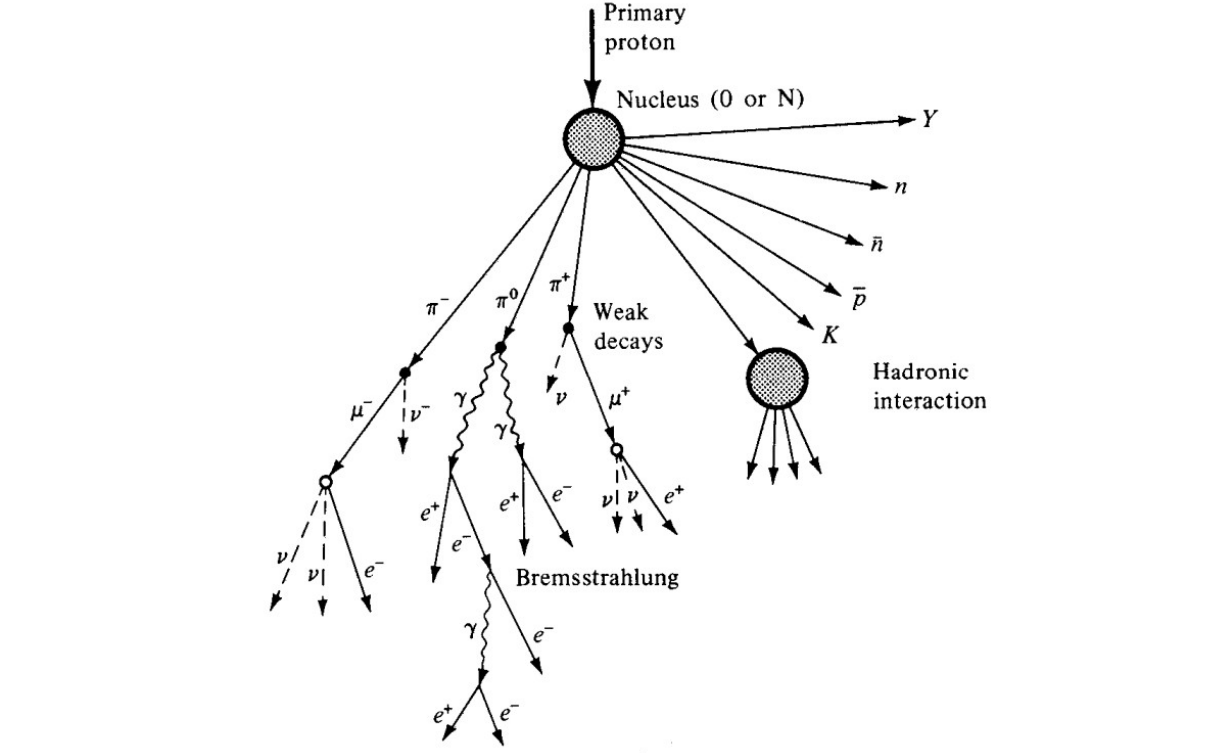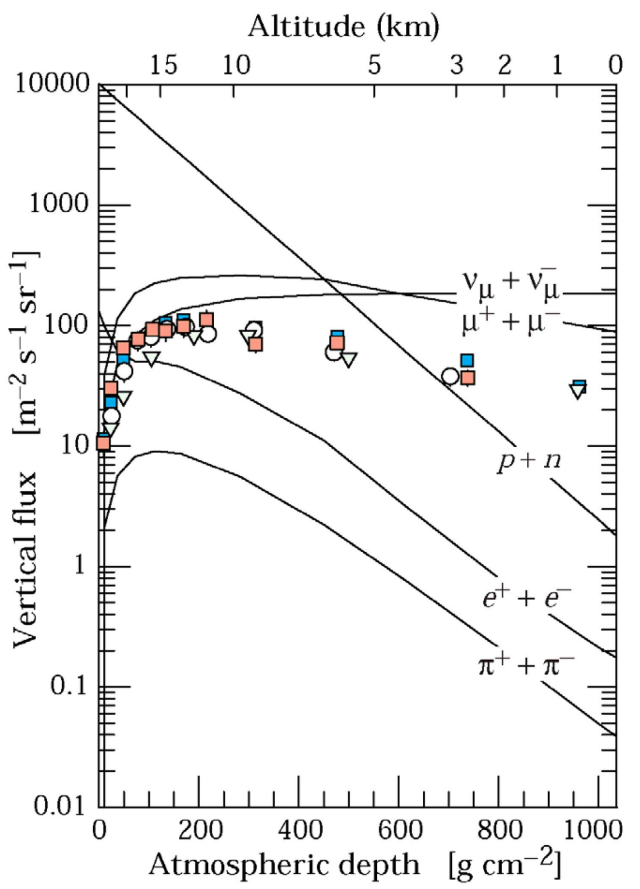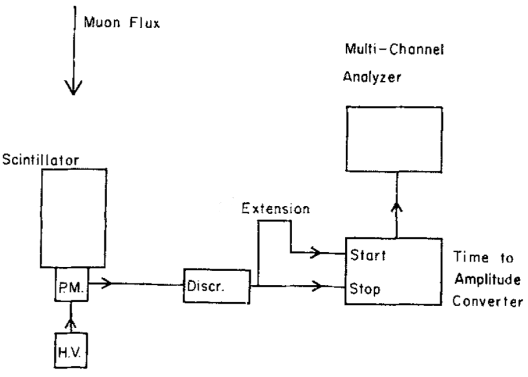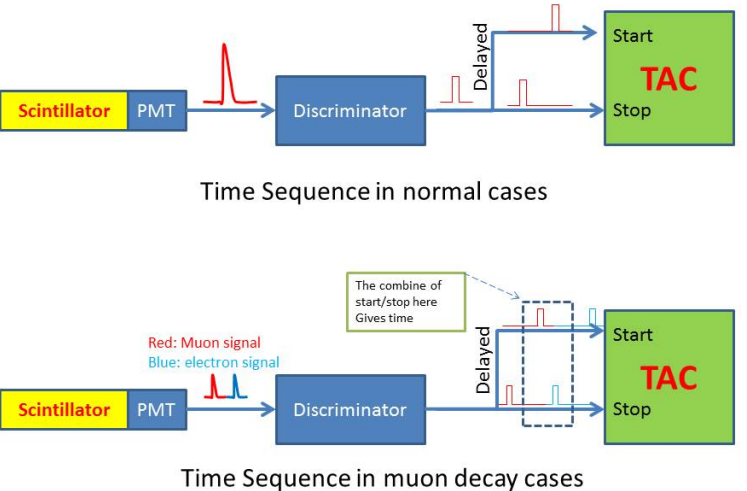Abstract
In the experiment, you will learn how to use plastic scientillator to measure lifetime of muon in cosmic ray. The basic particle detection skills will be shown in this activity, including how to using a PMT detector, signal processing methods, and data analysis skills etc.
译:
在这个实验中, 你将学习如何使用塑料科学仪器来测量宇宙射线中 $\mu$ 子的寿命. 在这个活动中, 将展示基本的粒子检测技能, 包括如何使用 PMT 检测器、信号处理方法和数据分析技能等.
Introduction
Muon was discovered by Carl D. Anderson in 1936 in studying of cosmic radiation. Just like its cousin electron, muon does not take part in strong interaction, bus has mass roughly 200 times larger than that of electron. Because its short lifetime, the muon from out space normally decay out before they arrive earth. Therefore, muons which come into our laboratory are the results of the interactions between protons and the nuclei in our atmosphere, principally nitrogen, oxygen and argon. At top of the atmosphere, the incoming protons are traveling at relativistic speeds. When they penetrate the atmosphere, many particles like $\pi^{0,\pm}, n, K$, etc. can be created due to the interactions and theirs sequencial reactions.
缪子是由卡尔-D-安德森在1936年研究宇宙辐射时发现的. 就像它的表亲电子一样, $\mu$ 介子不参与强相互作用, 其质量大约是电子的200倍. 由于它的寿命很短, 来自太空的 $\mu$ 介子通常在到达地球之前就已经衰变了. 因此, 进入我们实验室的 $\mu$ 介子是质子和我们大气层中的核子(主要是氮、氧和氩)之间相互作用的结果. 在大气层的顶部, 进入的质子以相对论级别的速度飞行. 当它们穿透大气层时, 由于相互作用和它们的连续反应, 许多粒子如 $\pi^{0,\pm}, n, K$ 等可以被创造出来.
The muons which will be detected in this experiment are the results of these reactions.(Fig.1), i.e.: $$ \pi^{+} \rightarrow \mu^{+}+\nu_{\mu} \\ \pi^{-} \rightarrow \mu^{-}+\bar{\nu_{\mu}} \\ $$
and then the muon will decay to:
$$ \mu^{+} \rightarrow e^{+}+\bar{\nu_{\mu}}+\nu_{e} \\ \mu^{-} \rightarrow e^{-}+\nu_{\mu}+\bar{\nu_{e}} \\ $$
The muon flux in the atmosphere is shown in Fig. 2
本实验将检测到的 $\mu$ 介子是这些反应的结果. (图1), 即: $$ \pi^{+} \rightarrow \mu^{+}+\nu_{\mu} \\ \pi^{-} \rightarrow \mu^{-}+\bar{\nu_{\mu}} \\ $$
然后缪子会衰变为:
$$ \mu^{+} \rightarrow e^{+}+\bar{\nu_{\mu}}+\nu_{e} \\ \mu^{-} \rightarrow e^{-}+\nu_{\mu}+\bar{\nu_{e}} \\ $$

大气层中的 $\mu$ 介子通量如图2所示.

Experimental Setup
The system is shown in Fig.3. A muon may traverse through the plastic scintillator or stop inside due to its energy. The energy loss in the scintillator is transformed into scintillator light and then is collected by the photomultiplier tube (PMT). The output signal from PMT is sent to discriminator which, once be triggered, can generate a few-ns-wide pulse. The pulse is splited to two, and send to the start and stop of a time-to-amplitude converter (TAC).
该系统如图3所示.

一个 $\mu$ 介子根据其能量大小, 可能会穿越塑料闪烁体, 也可能而停在闪烁器里面. $\mu$ 介子在闪烁器中的能量损失被转化为闪烁器的光, 然后被光电倍增管(PMT)收集. PMT的输出信号被送到鉴别器, 一旦被触发, 可以产生一个几ns宽的脉冲. 该脉冲被分成两个, 并被送到时间-振幅转换器(TAC)的开始和停止位置.
The cable to the start input of the TAC is roughly 3 meters longer than the cable to the stop input of the TAC.
At normal state, the TAC is ready to accept a start pulse. It ignores the stop pulse. The signal delayed 3 meter long cable start the TAC, and let it waiting another event come in.
But normally, nothing come in to stop the TAC during the maximum time range of TAC. But if a muon is stopped in the scintillator, its decay products, an electron or position, can cause another pulse, which servers as stop signal.
This stop signal, together with the start signal induced by muon itself, gives the time spectrum of the muon’s decay.
通向TAC的启动输入的电缆大约比通向TAC的停止输入的电缆长3米.
在正常状态下, TAC 准备接受一个启动脉冲. 此时它忽略了停止脉冲. 被延迟了传播3米长电缆所需时间的信号启动 TAC, 并让它等待另一个事件的到来.
但通常情况下, 在 TAC 的最大接收时间范围内, 没有任何东西会激发信号来停止 TAC.
但是如果有一个 $\mu$ 介子被停止于闪烁体中, 它的衰变产物, 即一个电子或位置(注:这里的位置可能是由于被误译为position,个人猜测应该是正电子), 可以引起另一个脉冲, 可以被当成停止信号.
这个停止信号, 加上 $\mu$ 介子本身引起的启动信号, 给出了 $\mu$ 介子衰变的时间谱.
The time sequence is shown in Fig.4.
时间顺序如图4所示.

Experimental Procedure
-
According to the Fig.3, set up the electronics;
根据图3, 设置好电子装置;
-
High Voltage is used here, you can not do it at the first time without supervised. Tune the HV for the PMT carefully, and monitor the out signals at the oscilloscope;
本次实验涉及使用高压电, 实验者不可以在无监督下进行首次实验. 仔细调整 PMT 的高压, 并在示波器上监测输出的信号;
-
Tune the threshold of the $\color{red}{discriminator}$ carefully, to cut the background noise;
仔细调整$\color{red}{鉴别器}$的阈值以排除背景噪音;
-
Monitor the start and stop signals on $\color{red}{oscilloscope}$ to make sure the stop signal is normally earlier than start signals;
在$\color{red}{示波器}$上监测启动和停止信号, 确保停止信号通常早于启动信号;
-
Start data acquisition system to record the time spectrum. You may need to wait few days to have the time spectrum;
启动数据采集系统以记录时间谱. 时间谱可能需要耗费数天才会得到.
-
Analyze the time spectrum you obtained. Fit the curve to get the lifetime.
分析所得到的时间谱. 拟合曲线以得到 $\mu$ 子寿命.
Questions
-
It is well accepted that “free muon” lifetime is $\tau_{\mu} = 2.1969811(22) × 10^{−6}$, and $\tau_{\mu +} /\tau_{\mu -} = 1.00002 \pm 0.00008$. Does your result agree with that? Are the muons “free” in our setup?
“自由$\mu$介子"的寿命是$\tau_{\mu} = 2.1969811(22) × 10^{−6}$, 而$\tau_{\mu +} /\tau_{\mu -} = 1.00002 \pm 0.00008$. 你的结果与此一致吗? 缪子在我们的实验装置中是"自由"的吗?
答案自由$\mu$介子指的是未曾与物质发生相互作用的$\mu$介子, 其寿命是已知的, 且自由$\mu$介子还有一个特征就是整体呈现电中性(也就是$\tau_{\mu +} /\tau_{\mu -}\approx 1$)
根据以上特征, 可以得知我们在实验室中测得的缪子是否为自由介子.
-
Taking into account the fact that there are muons and anti-muons in the (mixed) muon flux, how to interpret the results we obtained? Note that muons can also be captured by normal matter (proton and nucleus) via $$ \mu^{-}+p \rightarrow n+\nu_{\mu} \\ $$ thus making the muons appear to have a shorter lifetime (due to this additional capture process). The muons’ capture rate depends on the $Z$ of the interacting matter (in our case, the plastic scintillator has $Z = 6$ for carbon) by $Z^4$. For $Z = 10$, it is known that the (negative) muons would have $1/2$ of the “free muon” lifetime.
Assuming we have equal fractions of muons and anti-muons in the experiment, what is the expected value for the muon lifetime? Does your result agree with the expectation? In reality, we normally see more anti-muons than muons in the experiment (why?), say, $55%$ vs. $45%$, does this make your result agree more (or less) with the expected value?
如果考虑混合 $\mu$ 子流中存在的 $\mu$ 子和反 $\mu$ 子, 如何解释我们得到的结果?
请注意, $\mu$ 子也可以通过以下方式被普通物质(质子和核子)俘获, $$ \mu^{-}+p \rightarrow n+\nu_{\mu} \\ $$ 从而使 $\mu$ 子的寿命看起来更短(由于这个额外的俘获过程). 因此, $\mu$ 子的俘获速率取决于与之相互作用的物质的$Z$数的$4$次方(在我们的情况下, 塑料闪烁体的碳的$Z$为$6$). 对于$Z = 10$, 已知(负) $\mu$ 子将具有“自由 $\mu$ 子”寿命的$1/2$.
假设实验中 $\mu$ 子和反 $\mu$ 子的比例相等, 那么 $\mu$ 子寿命的期望值是多少? 你的结果是否符合期望?
答案我们可以将$\mu$子的寿命分为两种情况:自由$\mu$子和被物质俘获的$\mu$子。其中,被物质俘获的$\mu$子的寿命会看起来更短,因为它们被俘获后会与物质发生相互作用,从而导致寿命的缩短。
根据已知信息,对于$Z=10$的物质,$\mu$子的寿命会缩短到自由$\mu$子寿命的$1/2$。而在实验中,我们使用的是$Z=6$的物质,因此我们可以估算出被俘获的$\mu$子的寿命相对于自由$\mu$子寿命的比例为$(6/10)^4=0.1296$。
因此,我们可以将$\mu$子的寿命期望值表示为:
$$ \begin{aligned} \tau &= P(\mu \text{为自由}\mu\text{子})\times \tau_{\mu} + P(\mu \text{被俘获})\times \frac{1}{2}\tau_{\mu} \\ &= \frac{1}{2}\tau_{\mu} + 0.1296\times \frac{1}{2}\tau_{\mu} \\ &= 0.614\times \tau_{\mu} \\ &= 1.347 \times 10^{-6}\text{s} \end{aligned} $$
因此,$\mu$子的寿命期望值为$1.347 \times 10^{-6}\text{s}$。
在现实中, 我们通常在实验中看到更多的反 $\mu$ 子而非 $\mu$ 子(为什么?),
答案这是因为反$\mu$子与正电子(即反质子)的衰变产物具有更长的寿命,这使得它们在实验室中更容易被探测到。此外,在宇宙射线中,反$\mu$子比$\mu$子更容易产生,因此在实验中观测到更多的反$\mu$子也是可能的。比如说, 55%对45%, 这是否使你的结果更符合期望值?
答案根据题目中的信息,我们可以得到以下计算步骤:
-
计算负$\mu$子的自由寿命 $$ \tau_{\mu^-} = \tau_{\mu} = 2.1969811(22) \times 10^{-6} s $$
-
计算负$\mu$子在实验中被俘获的速率相对于自由寿命的比例 $$ \frac{1}{\tau_{\mu^-}} = \frac{1}{\tau_{\mu}} + \lambda_{\text{capt}} \\ \lambda_{\text{capt}} = \frac{1}{\tau_{\mu^-}} - \frac{1}{\tau_{\mu}} = 194.6 \text{ s}^{-1} $$
-
计算负$\mu$子在实验中的寿命期望值 $$ \tau_{\text{exp}}^- = \frac{1}{\frac{45}{100}\lambda_{\mu^-} + \frac{55}{100}\lambda_{\bar{\mu}^-}} = 2.048 \times 10^{-6} \text{ s} $$
-
根据题目中的信息,正$\mu$子的寿命期望值与负$\mu$子的寿命期望值相同,即 $$ \tau_{\text{exp}}^+ = \tau_{\text{exp}}^- = 2.048 \times 10^{-6} \text{ s} $$
因此,$\mu$子的寿命期望值为 $2.048 \times 10^{-6}$ 秒。
将 反$\mu$子/$\mu$子视为变量$k$:
答案 -
-
Can the background radiations show up in the time spectrum you measured? How to subtract them?
背景辐射能在你测量的时间光谱中显示出来吗? 如何除去它们?
答案实验中的第三步确保将背景辐射从数据中剔除:
- Tune the threshold of the $\color{red}{discriminator}$ carefully, to cut the background noise;
仔细调整$\color{red}{鉴别器}$的阈值以排除背景噪音;
Lab Report Format
- Title
- Abstract
- Introduction
- Methods, Materials and Procedures
- Results and Discussions
- Answers to Questions and More Discussions
- Conclusions
- Appendices
1. 标题
2. 摘要
3. 简介
4. 方法、材料和程序
5. 结果和讨论
6. 对问题的回答和更多讨论
7. 结论
8. 附录

